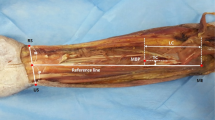Abstract
Hypertonia of the upper limb due to spasticity causes pronation of the forearm and flexion of wrist and fingers. Nowadays this spasticity is often treated with injections of botulinum toxin and sometimes with selective fascicular neurotomy. To correctly perform this microsurgical technique, it is necessary to get precise knowledge of the extramuscular nerve branching in order to be better able to select the motor branches which supply the muscles involved in spasticity. The same knowledge is required for botulinum toxin injections which must be made as near as possible to the zones where intramuscular nerve endings are the densest, which is also where neuromuscular junctions are the most numerous. Thus, it is necessary to better know these zones, but their knowledge remains today imprecise. The muscles of the anterior compartment of 30 forearms were dissected, first macroscopically, then microscopically, to study the extra- and intramuscular nerve supply and the distribution of terminal nerve ramifications. The results were then linked to surface topographical landmarks to indicate the precise location of motor branches for each muscle with the aim of proposing appropriate surgical approaches for selective neurotomies. Then for each muscle, the zones with the highest density of nerve endings were divided into segments, thus determining the optimal zones for botulinim toxin injections.












Similar content being viewed by others
References
Bouttens D, Delecourt C (2003) Les traitements orthopèdiques des conséquences de la spasticité au membre supérieur. Neurochirurgie 49:353–357
Brash JC (1955) Neuro-vascular hila of limb muscles. E&S Livingstone, Edinburgh, p 100
Brashear A, Gordon MF, Elovic E, Kassicieh VD, Marciniak C et al (2002) Intramuscular injection of botulinum toxin for the treatment of wrist and finger spasticity after a stroke. N Engl J Med 347:395–400
Brunelli G, Brunelli F (1983) Partial selective denervation in spastic palsies (hyponeurotization). Microsurgery 4:221–224
Canovas F, Mouilleron P, Bonnel F (1998) Biometry of the muscular branches of the median nerve to the forearm. Clin Anat 11:239–245
Chantelot C, Feugas C, Guillem P et al (1992) Innervation of the medial epicondylar muscles: an anatomic study in 50 cases. Surg Radiol Anat 21:165–168
Coers C (1953) Contribution à l’étude de la jonction neuromusculaire. Topographie zonale de l‘innervation motrice terminale dans les muscles striés. Arch Biol (Liège) 64:495–505
Decq P, Filipeti P, Cubillos A, Slavov V, Lefaucheur JP, Nguyen JP (2000) Soleus neurotomy for treatment of the spastic equinus foot. Neurosurgery 47:1154–1161
Decq P, Filipetti P, Feve A et al (1997) Peripheral selective neurotomy of the brachial plexus collateral branches for the treatment of the spastic shoulder: anatomical study and clinical results in five patients. J Neurosurg 86:648–653
Deltombe T, Gustin T, Laloux P, De Cloedt P, De Wispelaere JF, Hanson P (2001) La neurotomie fasciculaire sélective dans le traitement du pied varus équin spastique de l’enfant infirme moteur d’origine cérébrale. Acta Orthop Belg 67:1–5
Edward A, Hurvitz MD, Gerry E, Conti MS, Susan H, Brown PhD (2003) Changes in movement characteristics of the spastic upper extremity after botulinum toxin injection. Arch Phys Med Rehabil 84:444–454
Gros C (1972) La chirurgie de la spasticité. Neurochirurgie 23:317–388
Gunther SF, DiPasquale D, Martin R (1992) The internal anatomy of the median nerve in the region of the elbow. J Hand Surg (Am) 17:648–656
Hovelacque A (1927) Anatomie des nerfs crâniens et rachidiens et du système grand sympathique chez l’homme. Doin, Paris, pp 425–513
Hua J, Kumar VP, Pereira BP, Lim AY, Pho RW, Liu J (1999) Split flexor carpi radialis muscle. Plast Reconstr Surg 103:930–936
Hurvitz EA, Conti GE, Brown SH (2003) Changes in movement characteristics of the spastic upper extremity: botulinum toxin injection. Arch Phys Med Rehabil 84:444–454
Lim AY, Kuman VP, Hua J et al (1999) The neuromuscular compartments of the flexor carpi ulnaris. Plast Reconstr Surg 103:1046–1051
Lim AY, Kumar VP, Hua J, Pereira BP, Pho RW (1999) The neuromuscular of the flexor carpi ulnaris. Plast Reconstr Surg 103:1046–1051
Liu J, Lau HK, Pereira BP (1995) Terminal nerve branch entries (motor points) of forearm muscles: a comparative study between monkey and human. Acta Anat 155:41–49
Lorenz F (1887) Über chirurgische Behandlung der angeborenen spastischen Gliedstarre. Wien Klin Rdsch 21:25–27
Msaddi AK, Mazroue AR, Shahwan S, Al Amri N, Dubayan N, Livingston D, Moutaery KR (1997)Microsurgical selective peripheral neurotomy in the treatment of spasticity in cerebral-palsy children. Stereotact Funct Neurosurg 69:251–258
O’Brien CF (1997) Injection techniques for botulinum toxin using electromyography and electrical stimulation. Muscle Nerve 6(suppl):176–180
Page SJ, Elovic E, Levine P, Sisto SA (2003) Modified contraint-induced therapy and botulinum toxin A: a prom combination. Am J Phys Med Rehabil 82:76–80
Parratte B, Tatu L, Vuillier F, Diop M, Monnier G (2002) Intramuscular distribution of nerves in the human triceps surae muscle. Anatomical bases for treatment of spastic group foot with botulinum toxin. Surg Radiol Anat 24:91–96
Rousseaux M, Kozlowski O, Froger J (2002)Efficacy of botulinum toxin A in upper limb function of hemiplegic patients. J Neurol 249:76–84
Schwarzacher von HG (1957) Zur Lage der motorischen Endplatten in den Skelettmuskelen. Acta Anat 30:758–774
Scott AB (1980) Botulinum toxin injection into extraocular muscles as an alternative to strabismus surgery. Ophthalmology 87:1044–1049
Segal RL, Catlin PA, Krauss EW et al (2002) Anatomical partitioning of three human forearm muscles. Cells Tissues Organs 170:183–197
Segal RL, Wolf SL, De Camp MJ et al (1991) Anatomical partitioning of three multiarticular human muscles. Acta Anat (Basel) 142:261–266
Shaari CM, Sanders I (1993) Quantifying how location and dose botulinum toxin injections affect muscle paralysis. Muscle Nerve 16:964–969
Stoffel A (1912) The treatment of spastic contractures. Am J Orthop Surg 10:611–644
Lanz T Von, Wachsmuth W (1959) Practische Anatomie. Arm. Springer; Berlin-Göttingen-Heidelberg, p 144
Author information
Authors and Affiliations
Corresponding author
Rights and permissions
About this article
Cite this article
Lepage, D., Parratte, B., Tatu, L. et al. Extra- and intramuscular nerve supply of the muscles of the anterior antebrachial compartment: applications for selective neurotomy and for botulinum toxin injection. Surg Radiol Anat 27, 420–430 (2005). https://doi.org/10.1007/s00276-005-0012-9
Received:
Accepted:
Published:
Issue Date:
DOI: https://doi.org/10.1007/s00276-005-0012-9




